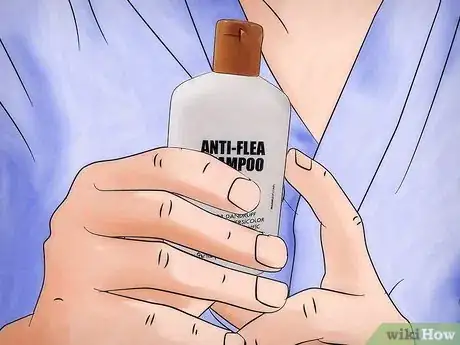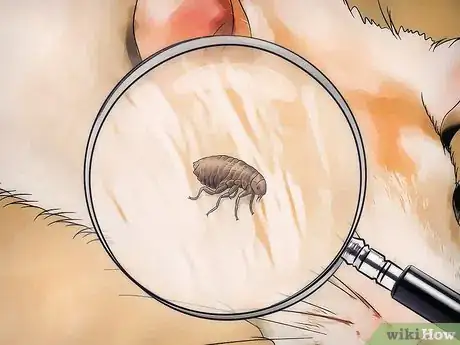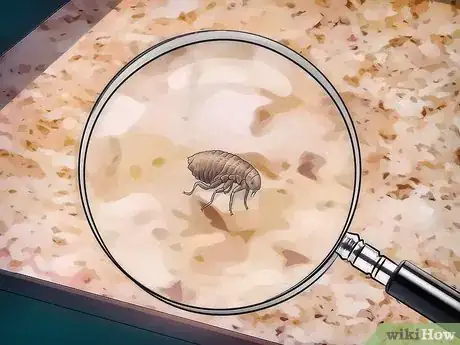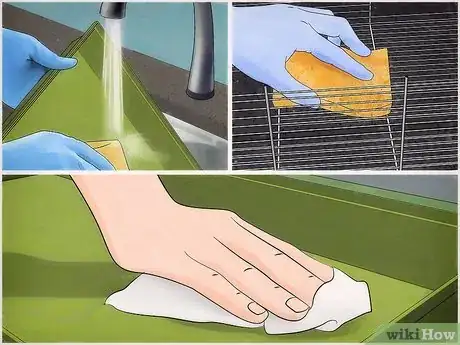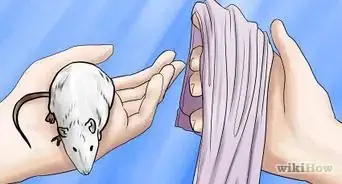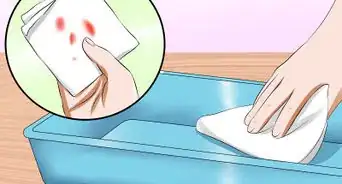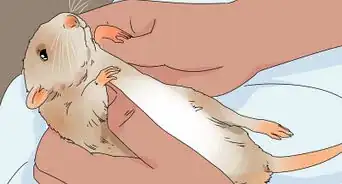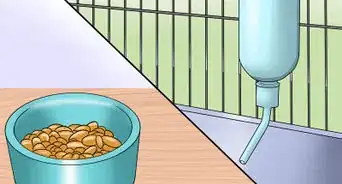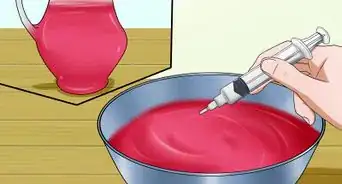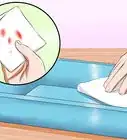This article was co-authored by Brian Starr. Brian Starr is a Rat Specialist and Breeder and the Owner of OC Dumbos out of Central Florida. As America’s only breeder of pet Roof Rats, Brian and OC Dumbos specialize in rat breeding, training, and care. Years of experience and several generations of careful breeding have allowed Brian and OC Dumbos to create a line of tame Roof Rats, bred to make friendly, fun pets. In addition to offering rat accessories and training resources, OC Dumbos also offers free Roof Rat adoptions.
wikiHow marks an article as reader-approved once it receives enough positive feedback. In this case, 80% of readers who voted found the article helpful, earning it our reader-approved status.
This article has been viewed 99,043 times.
Fleas are not commonly found in rats, but they can be transmitted to your pet rat from cats and dogs, or from other wild rodents. For any flea infested animal, persistent flea treatment and maintenance is the key to ensuring that your pet and environment is flea-free.
Steps
Cleaning Your Rat
-
1Bathe your rat using flea medicated shampoo. Using your vet's recommended flea shampoo, bathe your rat. It is very important to leave the flea shampoo on your rat for about 10 minutes in order for the medication to take effect.[1]
- Lather your rat with flea shampoo out of the water so the shampoo isn't washed away. Try putting your rat on a towel as you lather them so they don't slip away or make a mess. Or simply hold your rat in your hand while you wait the allotted 10 mins as the shampoo treats your rat's fleas.
- Don't get shampoo in your rat's eyes, ears, and mouth. The shampoo is strongly medicated and can be toxic when ingested by your rat. So keep a constant eye on them as you wait the allotted time for the shampoo to work.
- Be sure to clean your rat's tail as well. Use a toothbrush and lightly lather the shampoo onto their tail. Be careful not to scrub too hard as a rat's tail skin is easily damaged.
- Let your rat swim around in their bath to drown out the fleas.
-
2Use a flea comb to remove fleas. This can be done at any time to remove dead or live fleas from your rat. This is a great tool to use especially if your rat can't handle strong medication due to illness. Comb your rat with a flea comb and then place your comb in hot, soapy water to kill the fleas.
- This method may take a considerable amount of time before you are able to rid your rat of all fleas.
- This does not help with flea bite sensitivity and does not treat your rat for skin irritation problems. Flea shampoos not only kill fleas but also helps to sooth your rat's skin.
- This method requires you to be able to handle your rat, especially if you don't have a trained rat. You may need to restrain or keep you rat still while combing by making a claw-like gesture with your hand to keep your rat in place. Hold your rat by placing your thumb and ring finger around its body right under its front legs, while having your rat's neck rest between your index finger and middle finger. Don't squeeze too hard or you'll restrict its airway. You can attempt the same holding method with your rat on its back.[2]
Advertisement -
3Give topical flea treatments to your rat. Your vet can recommend topical flea treatments like sprays or once-a-month topical insecticides to be applied to your rat.[3] These are often applied to a spot on your rat's body where they can't lick or ingest the medication. The medication seeps into your rat's bloodstream to protect it from future parasites. This is done as a preventative measure rather than a cure for fleas.
- Never use flea treatment products without consulting your veterinarian first.
- Never let your rat ingest flea treatments.
-
4Take your rat to your veterinarian. Before starting flea treatment, take your rat to the vet. Your vet will be able to identify if your rat has fleas or if they have another type of skin parasite or irritant. They can also recommend treatment options and products to use and provide helpful advice on how to safely and effectively remove fleas from your rat and its environment.
- Be sure to tell your vet you think your rat has fleas. Some vets may want you to take precautionary actions before bringing in a possibly flea-infested animal.
- Always talk with your vet first before treating your rat.[4]
Identifying Fleas
-
1Observe if your rat is scratching more than normal. Often a rat will scratch a flea infested part of its body more frequently and often quite vigorously. This area can become irritated, red, or inflamed from scratching and from fleas feeding on your rat's skin.[5]
- Missing patches of fur or red scabs is a good indication that something is irritating your rat's skin even if you don't see them scratching.
- Fleas like to hide in densely covered areas of animals. If your rat is scratching its armpits and belly a lot more than normal or has irritation in these areas, it might be a sign of fleas or some other skin irritant.
- Your rat might jump or react violently out of the blue. This is a sign of hypersensitivity to flea bites.
-
2Look for fleas in your rat's skin and fur. If the infestation is heavy, you will be able to spot fleas or its feces. Flea feces or flea dirt will look like coffee grounds on your rat's fur.[6] Use a flea comb or a comb with closely set teeth and run it through your rat's fur. Make sure to run it close to your rat's skin in order to catch and pull any fleas that are hiding under the fur coat. If your comb comes up with any black spots that are dirt-like, it may be fleas or its feces.
- Have a bowl of soapy water on hand to wash your comb of any fleas you might pull out.
- Flea feces and dirt can look quite similar, especially if you bring your rat outside to play. One way to tell the difference between the two is to wet any dirt-like specks with water and watch if the spots turn a reddish-brown colour. The red colour is the digested blood that the fleas have ingested which has been broken down by the water.
- Adult fleas account for about 5% of a flea colony or infestation. The other 95% consist of flea eggs, larvae, and pupae which are harder to see with the naked eye.
-
3Look for fleas in your rat's bedding. Check any areas your rat frequents or sleeps, or even areas near or under its cage. You might be able to see flea dirt or fleas in your rat's cage or bedding, especially if the flea infestation is quite heavy.
Controlling Fleas in Your Environment
-
1Do a deep clean of your rat's cage. Depending on how bad the flea infestation is, you will need to do a deep clean on your rat's cage every week. Flea infestations can take weeks and even months to cure. This is because most measures we take to get rid of fleas may only work on adult fleas, leaving the eggs to hatch and grow into adult fleas at a later date.
- Use a diluted bleach or a detergent to clean the cage. Wipe the bars, any wheels or platforms, and the outside and inside of the cage's pan. Rise thoroughly after.
- Soak toys in diluted bleach or detergent while you clean the cage. Rinse thoroughly after.
- Throw out and change the bedding and litter pan completely.
-
2Clean the area around your rat's cage. Wipe all surfaces with diluted bleach and treat the area with pet-safe and indoor-safe pesticides. Clean the area as much as your can, even daily, and treat the area according to the pesticide's instructions.
- Purchase and use an adulticide which kills all adult insects and an insect growth regulator that disrupts the hormonal balance of insects and prevents them from reproducing and laying eggs.[7]
-
3Vacuum your home. Vacuuming can remove up to 50% of flea eggs, stopping the the flea cycle drastically. After vacuuming, bag up the vacuum bag in a plastic bag and throw it away immediately. If you have a vacuum cleaner that doesn't use vacuum bags, consider finding one that does. If you don't discard the bag, the flea eggs can hatch inside your vacuum cleaner and start the flea cycle all over again.
- Vacuum daily in high traffic areas and weekly in other areas.
- Vacuum carpets, furniture, drapes, and wherever your rat sleeps or hangs out.
- You will have to keep this up for a few weeks and may months, until you're sure there are no longer fleas on your rat and in your home.
Expert Q&A
-
QuestionWhat medications can help my rat?
 Brian StarrBrian Starr is a Rat Specialist and Breeder and the Owner of OC Dumbos out of Central Florida. As America’s only breeder of pet Roof Rats, Brian and OC Dumbos specialize in rat breeding, training, and care. Years of experience and several generations of careful breeding have allowed Brian and OC Dumbos to create a line of tame Roof Rats, bred to make friendly, fun pets. In addition to offering rat accessories and training resources, OC Dumbos also offers free Roof Rat adoptions.
Brian StarrBrian Starr is a Rat Specialist and Breeder and the Owner of OC Dumbos out of Central Florida. As America’s only breeder of pet Roof Rats, Brian and OC Dumbos specialize in rat breeding, training, and care. Years of experience and several generations of careful breeding have allowed Brian and OC Dumbos to create a line of tame Roof Rats, bred to make friendly, fun pets. In addition to offering rat accessories and training resources, OC Dumbos also offers free Roof Rat adoptions.
Rat Specialist & Breeder Ask your vet about ivermectin. This medication will work against most external parasites.
Ask your vet about ivermectin. This medication will work against most external parasites. -
QuestionIs it okay to buy medications online?
 Brian StarrBrian Starr is a Rat Specialist and Breeder and the Owner of OC Dumbos out of Central Florida. As America’s only breeder of pet Roof Rats, Brian and OC Dumbos specialize in rat breeding, training, and care. Years of experience and several generations of careful breeding have allowed Brian and OC Dumbos to create a line of tame Roof Rats, bred to make friendly, fun pets. In addition to offering rat accessories and training resources, OC Dumbos also offers free Roof Rat adoptions.
Brian StarrBrian Starr is a Rat Specialist and Breeder and the Owner of OC Dumbos out of Central Florida. As America’s only breeder of pet Roof Rats, Brian and OC Dumbos specialize in rat breeding, training, and care. Years of experience and several generations of careful breeding have allowed Brian and OC Dumbos to create a line of tame Roof Rats, bred to make friendly, fun pets. In addition to offering rat accessories and training resources, OC Dumbos also offers free Roof Rat adoptions.
Rat Specialist & Breeder You can buy them online if you know what you're doing. However, you probably shouldn't do this unless you have a lot of rat expertise.
You can buy them online if you know what you're doing. However, you probably shouldn't do this unless you have a lot of rat expertise. -
QuestionDo I have to take my rat to the vet to get the fleas out?
 Community AnswerYou shouldn't have to go to the vet, and you should be able to find a wash of some sort for fleas.
Community AnswerYou shouldn't have to go to the vet, and you should be able to find a wash of some sort for fleas.
Warnings
- Never allow your rat or any other pets to ingest flea medication. Bring your pet to your vet or emergency vet immediately if flea medication is ingested.⧼thumbs_response⧽
References
- ↑ http://www.peteducation.com/article.cfm?c=0+1333&aid=590
- ↑ http://ratguide.com/care/grooming/bathing.php
- ↑ Brian Starr. Rat Specialist & Breeder. Expert Interview. 27 April 2021.
- ↑ Brian Starr. Rat Specialist & Breeder. Expert Interview. 27 April 2021.
- ↑ http://www.petmd.com/exotic/conditions/skin/c_ex_rt_fleas
- ↑ http://www.vetstreet.com/care/a-pet-owners-guide-to-flea-control
- ↑ http://npic.orst.edu/ingred/ptype/igr.html
About This Article
To get rid of fleas on a rat, bathe it using a flea medicated shampoo, and leave the shampoo on for 10 minutes so it has time to work. You can also remove fleas by brushing your rat with a flea comb and then dunking the comb in soapy water to kill the fleas. Or, you can take your rat to the vet to get a prescription topical flea medication, which will kill fleas and help protect your rat from future infestations. To learn how to get rid of fleas in your rat's habitat, scroll down!
